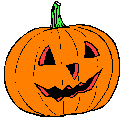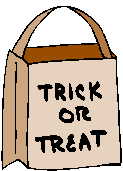

Pumpkin Trivia and What to Do With Your Pumpkin After Halloween Pumpkin
Pumpkins are great for much more than carving! Pumpkins provide 53% of our vitamin A, 20% of our vitamin C, and 564 mg. of potassium. So if you never got around to carving that pumpkin, you might want to cook your pumpkin!
The name pumpkin originated from "pepon" - the Greek word for "large melon." Native Americans used pumpkin seeds for food and medicine. American colonists sliced off pumpkin tips; removed seeds and filled the insides with milk, spices and honey. This was baked in hot ashes and is the origin of our pumpkin pie, although it is recorded that they also used pumpkins as an ingredient for the crust of pies, not the filling.
It is true that special varieties of pumpkins (called, most obviously "pie pumpkins") make the smoothest pumpkin pie, but even a jack-o-lantern type pumpkin makes a pretty good pie. See the easy, illustrated directions for pumpkin pie, soup, bread or other tasty treats!
A Random Collection of Pumpkin Facts... or Trivia
- Pumpkins are fruits, a type of squash that cucumbers, squashes and melons.
- Pumpkins are native to North America and have been domestically grown there for five thousand years.
- In 1584, after French explorer Jacques Cartier explored the Saint Lawrence region of North America, he reported finding "gros melons" (large melons). The name was translated into English as "pompions," which has since evolved into the modern "pumpkin."
- Pumpkins are low in calories, fat, and sodium and high in fiber. They are good sources of Vitamin A, Vitamin B, potassium, protein, and iron.
- The largest pumpkin ever grown was over 1100 by a man in Ohio, in 2000.
- Pumpkins require a long hot growing season and loads of humus, manure and water.
- Pumpkin seeds can be roasted as a snack. See this page for directions.
- Pumpkins contain potassium and Vitamin A.
- Pumpkins are used for feed for animals.
- Pumpkin flowers are edible.
- Pumpkins are used to make soups, pies and breads.
- The largest pumpkin pie ever made was over five feet in diameter and weighed over 350 pounds. It used 80 pounds of cooked pumpkin, 36 pounds of sugar, 12 dozen eggs and took six hours to bake.
- Pumpkins are members of the vine crops family called cucurbits. They are easy to grow! See this page for how to grow your own pumpkins!
- Pumpkins originated in Central America.
- In early colonial times, pumpkins were used as an ingredient for the crust of pies, not the filling.
- Pumpkins were once recommended for removing freckles and curing snake bites.
- Pumpkins range in size from less than a pound to over 1,000 pounds.
- The largest pumpkin ever grown weighed 1,140 pounds. See this page for this year's largest pumpkin.
- The name pumpkin originated from "pepon" - the Greek word for "large melon."
- The Connecticut field variety is the traditional American pumpkin.
- Pumpkins are 90 percent water.
- Eighty percent of the pumpkin supply in the United States is available in October.
- In colonial times, Native Americans roasted long strips of pumpkin in an open fire.
- Colonists sliced off pumpkin tips; removed seeds and filled the insides with milk, spices and honey. This was baked in hot ashes and is the origin of pumpkin pie.
- Native Americans flattened strips of pumpkins, dried them and made mats.
- Native Americans called pumpkins "isqoutm squash."
- Native Americans used pumpkin seeds for food and medicine.
- The first carved Halloween Jack O'Lanterns were made from turnips, not pumpkins
What to Do With Your Carved Pumpkin After Halloween Pumpkin
Of course, if you already carved it as a jack-o-lantern, here are some do's and don't's for your carved pumpkin:
Do:
- Put it in the compost heap - it will make good fertilizer
- Bury it in the garden - it will decay quickly and enrich the soil
- Wash, dry and save the seeds to plant next year (they will grow!)
- Wash and roast the seeds - they make good eating.
- Dump it in the trash, if you haven't got a garden
Don't:
- Use it as a door stop
- Keep it indoors: it will rot and stain the floor
- Put it in the attic for next Halloween
- Attempt to eat it or cook with it.
- Use it in cold fusion experiments (pumpkinfusion has been disproven ).
Sources and references
- Rogers, Nicholas (2002). "Samhain and the Celtic Origins of Halloween". Halloween: From Pagan Ritual to Party Night, pp.11-21. New York: Oxford University Press. ISBN 0-19-516896-8
- Roger, Nichola (2002). Halloween: From Pagan Ritual to Party Night. Oxford University Press. pp. 28-30. ISBN 0-19-514691-3.
- Arnold, Bettina (2001-10-31). "Bettina Arnold - Halloween Lecture: Halloween Customs in the Celtic World" . Halloween Inaugural Celebration. University of Wisconsin-Milwaukee: Center for Celtic Studies. http://www.uwm.edu/~barnold/lectures/holloween.html . Retrieved 2007-10-16.
- Skal, David J. (2002). Death Makes a Holiday: A Cultural History of Halloween, p.34. New York: Bloomsbury. ISBN 1-58234-230-X.
- Pope John Paul, July 1994, conversation with the author in Rome, Italy
Halloween Costumes
Here are some of the most popular Halloween costumes for children this year. For more choices, see our Halloween costumes pages.
- Inflatable Riding Dinosaur Costume for Adults - everyone LOVES this costume. It's a hit where ever you go!
- Harry Potter Costume Kids Plush Robe - With a hood, one for each house, Gryffindor, Hufflepuff, Slytherin, Ravenclaw, Hogwarts
- Wizard Robe Cloak Halloween costume for Kids
- Girl's Sparkle Princess Costume - In pink, for small girls
- Sew your own Halloween Costumes with Patterns from the Singer Sewing Reference Library
- Pizza Costume for Kids - A giant slice of pizza Halloween Costume for Children and Teens
- Easy Halloween Costumes for Children - Miniature patterns for 3 to 12 year old children, just enlarge and use
Find Related Information and Resources Here!
Here's the quick list to related farms for PYO, Honey, Pumpkins, Christmas trees, etc.:
You may find these websites useful!
- Local pick your own farms for apples, strawberries, raspberries, corn, tomatoes, etcr
- Farm markets and roadside stands
- Local Honey Finder
- Children's consignment sales
- Local Meat, Milk and Eggs
- Christmas Tree Farms and lots
- Road tripping and camping tips, tricks and How-to's
- Fun Factory Tours
- Venues for you event: Farms, Wineries, Orchards for your event, wedding or party
- Easter egg hunts
- Festivals: Fruit and vegetable festivals
- Winery tours and wine tastings
- Horses: rides, stables, lessons, trails
- Maple Syrup farms and sugarworks
- Bed and Breakfasts on Farms, Wineries, Ranches and Orchards
- Zombie Paintball venues
- Environmental resources
- Consumer fraud information
- Wholesale food sources
- Resources for Farmers
- Pumpkin patches
- Corn mazes
Water bath canning kit - 8 Piece Enamelware Pot with Canning kit and Rack. Canning Supplies Starter Kit
Double Donut Pumpkin Spice Coffee Pods, Single Serve Flavored Coffee for Keurig K Cups Machines,
Pumpkin Spice - Organic, 1.94-Ounce Jar, Nutmeg, Cloves, Ginger & Cinnamon, Enhances Tea, Seasoning, Kosher
Maud's Pumpkin Spice Instant Latte - 16 count Packets, Love Me Some Pumpkin Spice Latte
Pumpkin Pie Spice Blend Extract,McCormick Pure
Don't miss our page of costumes, ready made and ones you can make yourself!
And here's a book of 130 pumpkin carving stencils!
Pumpkin Carving stencils book - Over 130 Halloween jack olantern pumpkin designs. Including Witches, Cats, skulls, bats, ghosts, and so much more
More carving kits and stencils are here!
Find Other types of farms:
- Pick Your Own apples
- Christmas Tree Farms and lots
- Farm markets and roadside stands
- Local Honey
- Local Meat, Milk and Eggs
- Road trip and camping
Get the
most recent version of
the Ball Blue Book
Click here to get Halloween Costumes delivered - fast, great prices!
Click here to get Halloween Costumes delivered - fast, great prices!
Find Other types of farms:
- Pick Your Own apples
- Christmas Tree Farms and lots
- Farm markets and roadside stands
- Local Honey
- Local Meat, Milk and Eggs
- Road trip and camping
Get the
most recent version of
the Ball Blue Book